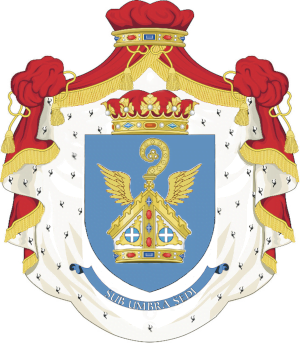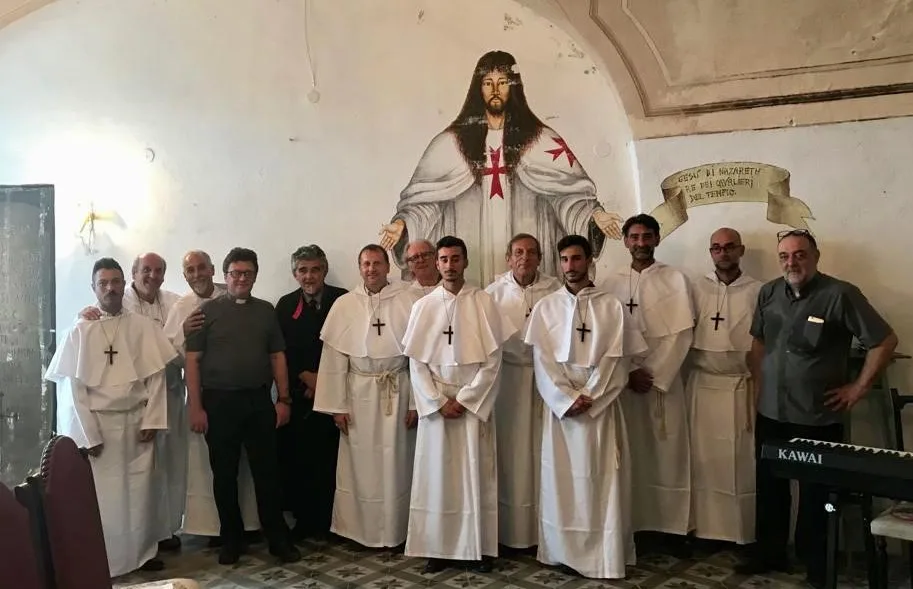Within the Monegasque Body of Worship called “Polish National Catholic Church à Monaco”, duly registered with the Ministry of State of the Principality of Monaco on 14 September 2018, the religious congregation called: “Monastic Order of Seborga” (abbreviated:. O.M.Seb.) was established by a specific resolution of the Assembly of Members.
The Order, organised in the first Chapter with headquarters in Seborga, is divided into three religious congregations
- primary order called the Order of Saint Michael
- secondary order called the Order of Mary of Magdala
- tertiary order called the Order of the Converse
The primary order is composed of monks, novices and clerics. The secondary order is composed of nuns and novices The tertiary order is composed of converts, who have taken minor vows, and lay people. The religious, clerics, monks, nuns, novices and tertiaries, intend to give themselves a special Rule, remembering that they must know and scrupulously observe the commandments given by God, so that, loving the Lord and the Holy Trinity with all their heart, mind, soul and strength, and loving their neighbour as ourselves, they may attain the fruit of eternal life. Religious and lay people have therefore come together to observe the Gospel of our Lord Jesus Christ, and to live in God our Lord. Therefore, since they must always observe this Rule, they will never try to escape from it, because “whoever puts his hand to the plough and turns back is not fit for the Kingdom of God”.
The Monastic Order of Seborga has its legal headquarters in the Principality of Monaco at the Association’s headquarters located at Palais de la Scala 1, Avenue Henry Dunant, and its historical-liturgical abbey headquarters in Italy, in Seborga (IM), at Via Maccario 1, in the heart of the ancient abbey principality.
The re-establishment of this Order, by the will of the Commendatory Abbot today, is in communion with the Orthodox Church in Italy and the Traditional Gallican Church of France, both recognised religious bodies. This momentous initiative is aimed at restoring the Ancient Order of Benedictine matrix that was established in Seborga by the Ancient Benedictine Fathers of the Island of Lerino, according to the rule instituted by Saint Benedict. The act of re-establishment is intended to emphasise the ecumenical values of the Holy Trinity or the fruitful and spiritually constant dialogue between Catholic and Orthodox Christians for the Unity of all Christians, as stated in the Gospel of St. John: “Ut unum sint” (that they may be one).
For further information visit: ordinemonastico.org
Why support the Monastic Order
Supporting our Italo-Monegasque religious organisation enables us to foster the dialogue of all Christians around the world so that they may be united in Christ.
Gathered in Seborga, the first Cistercian state of Humanity, destination of many Knights, inspired by St. Bernard of Clairvaux and St. John of Matha, we wish to rediscover that message of fraternal love that was taught by Christ Our Lord.
Join us and profess faith in Christ for the service and betterment of Humanity for the preservation of our beloved planet.
Why become a monk or a tertiary?
Being a monk in today’s world means sharing a unique experience of common life with other brothers, but it does not necessarily oblige you to live in chastity and community.
Our monks are mostly converts, that is, tertiaries who live with their families, but they share a common life with other brothers.
They devote the time they have available to volunteer with other confreres in the service of the Monastic Order and its spiritual guide, the Prince-Abate of Seborga, in order to build a place of common life in full respect with our planet and according to the principle of fraternal love imparted by Our Lord YOSHUA the Christ.
If you wish to have more information, contact us and we will send you the application form to become a Novice and if you wish to continue on this path of true fraternal love, you may become a Monk and Brother of the Abbey of Seborga.
Why become a lay volunteer?
To be a lay volunteer of the Monastic Order of Seborga means making yourself available to the monks and the Prince-Abbot of Seborga in order to support the work of ecumenical dialogue between all the Christians of the world and to assist in the work of re-establishing the Ancient Abbey State of Seborga.
You can make yourself available to serve the community and devote your free time to a very specific task according to your professional and cultural skills.
Employ your life in the service of your neighbour and you will rediscover that brotherly love you have always sought within yourself. This article offers free shipping for qualified Face mask products or buy online and pick up in shop today at the Medical Department
Join us and become a lay volunteer of the Monastic Order of Seborga.





